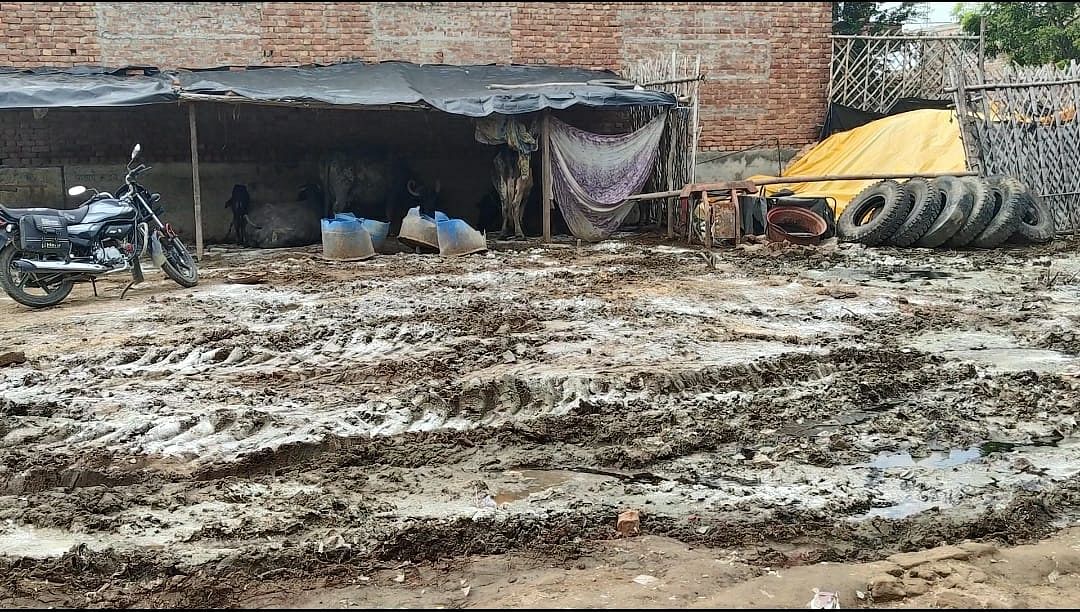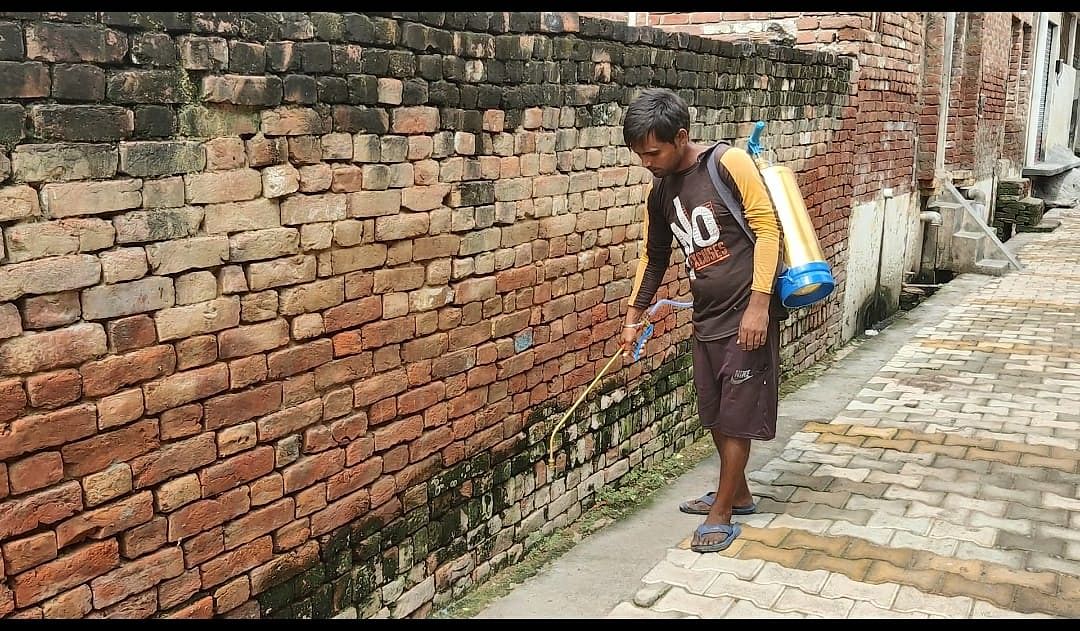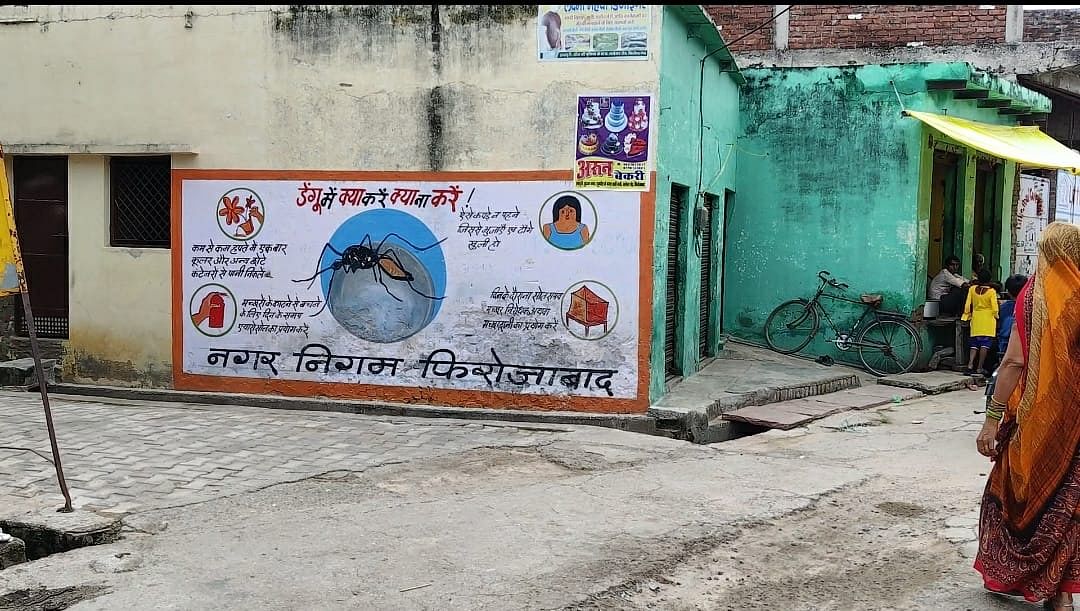Form of words:
Firozabad: both sides of Rehnas placenta, an 8-km sewage drain running through the city of Firozabad, is a slum. A foul smell permeates the air from the drain, and heavy rains have turned the unpaved roads here into swamps.
Rainwater has created ponds on some vacant plots of land in slums, and the boundaries of these water bodies are littered with waste dumped by local residents. Pigs, cows and crows sweep through the garbage for food while flies and mosquitoes fly here and there with abandon.
Garbage and water logging are common around the three areas of the city namely Sudama Nagar, Mahadev Nagar and Tharputha.

Residents of Tharputha said that they alone have lost 10-12 children to the ongoing outbreak of five diseases – dengue, malaria, scrub typhus, leptospirosis and viral fever – that have shook the district for over a month.
According to the official toll, there had been 63 deaths since August 20, when the outbreak was first identified as a “mysterious disease” affecting mainly children.
Dengue is a vector borne disease, has been identified by officials as the primary driver of the outbreak, which officials say is now on the upswing. The fact that children seem to be most affected has been attributed to the D2 strain of dengue, described by the district authorities As in “very toxic and more dangerous”.
Dengue is spread by mosquito bites, and prevention advice focuses on protecting against exposure to mosquitoes.
who guidelines Advise “Preventing mosquitoes from accessing egg-laying habitats” by “Environmental Management and Modification”. These include “disposing of solid waste properly and removing artificial man-made habitats that may hold water, covering, emptying and cleaning domestic water storage containers on a weekly basis, applying appropriate insecticides to outdoor water storage containers”. ” Are included.
In conversations with residents and officials, alleged violations of these guidelines were repeatedly cited to explain the outbreak, with both sides pointing fingers at each other.
However, district officials acknowledge that the shift in administration’s focus towards the COVID pandemic may be partly responsible for setting the stage for the outbreak.
According to the Integrated Disease Surveillance Program Portal of the Central Government – Where every district is compulsorily required to provide updated data on disease outbreaks every week – District have not reported Outbreak of any of the 5 diseases in the last three years.
Read also: People flee or send children in Firozabad because 5 diseases identified as ‘mysterious diseases’
‘We need cleanliness’
When ThePrint reached one of the worst affected areas, Sudama Nagar also visited On August 30, by Chief Minister Yogi Adityanath, it saw municipal corporation employees cleaning a plot that had a lot of garbage. Villagers say that regular cleaning is being done here for the last 15-20 days.

However, residents of Mahadev Nagar and Tharputha claimed that they have witnessed fogging and spraying only once since the outbreak.
“I’ve never seen sweeper (sweepers) in this area, very little with anti-mosquito medicine, and I have been living here for five years,” said 72-year-old Chokhe Lal, a resident of Mahadev Nagar.
“My house is right next to this plot with water, which is so big that you can call it a lake. Even after such a severe dengue outbreak, we are yet to see any action here.”
In Tharputha, residents were sitting on a hunger strike – going on for four days at the time – when this reporter arrived on 24 September. His demand was cleanliness.
“This is Municipal Corporation ward 32, and there has been no development in this area. The unpaved roads have become marshy, the water-logging is so bad that an empty plot behind the colony has become a pond and there is no way for the water to drain out,” said 25-year-old Vicky Yadav, a resident.
Due to this dengue has spread in the area. Let me tell you, at least 10 children are hospitalized, and we have lost 10-12 children, but even after so much death and destruction, no action has been taken yet.
On September 25, MLA Manish Asija gave him a written assurance that he would develop the area, after which the protesters called off the strike.
Similar issues were reported When ThePrint visited Two Firozabad villages – Nagla Aman and Nagla Mwasi village – last week.
Apart from Rehan placentaThere is another drain flowing through the city of Firozabad – Bamba placenta — and both take the sewage of the city with them.
Municipal commissioner Prerna Sharma said the district treats drain water at sewage control plants, and cleans drains every year before the rainy season, but noted that the public dumps plastic waste into the water that collects on the banks. gives.
“Since the public is accustomed to throwing plastic material into the drain… even after the outbreak, we cleaned the drains and found floating (plastic and other waste) in it, not silt,” she told ThePrint.
The commissioner said that open drains do not allow mosquitoes to breed as they have running water. On top of that, she said, the district has sprayed water with BTI (Bacillus thuringiensis subspecies israelensis,). an organic or naturally occurring bacterium found in soil) also as an anti-larval solution and insecticides.
Firozabad Chief Medical Officer Dinesh Kumar Premi said that improper storage of water in homes by people is also a factor in the outbreak. He said that most of the houses in Firozabad have running water only for an hour every day, due to which people collect and store large amount of water at home.
“Dengue mosquito lives inside the house. It usually has a lifespan of 10 days, and can infect entire families and breeds, which can then infect entire neighborhoods. In Firozabad urban, people store water in large tanks of up to 200 liters, which are often open, where larvae breed and cause infection,” he told ThePrint.
However, he appeared Accept possible lapses in preventive measures this season for dengue control. According to Lover, “probably” it was the increased focus on Covid that various cities municipalitys Failed to clean drains in time or spread awareness about dengue and malaria in the district this monsoon season.
However, he also pointed out that the rains this year have been heavy, sporadic and off-season, adding that it has contributed to creating favorable conditions for the outbreak.
Control measures underway
When asked about the steps being taken by the administration to control the outbreak, Municipal Commissioner Sharma said that they are spraying anti-larva drug and fogging the entire city.
He said that the corporation has also released 25,000 mosquito-eating fish in various ponds across the city and pulled out water from different places.
“The corporation has cleaned 25 plots that had garbage since the outbreak and 450 additional personnel were deployed in the affected areas for cleaning. The corporation has distributed 25,000 tubes of Odomos mosquito repellent in these areas,” she told ThePrint.

CMO Premi said the medical department is fighting the outbreak through a five-stage programme, consisting of house-to-house surveys and providing treatment to people displaying symptoms of fever, source reduction, which means water coolers and Storing and cleaning other places in the house, water in unpotable water, and spraying anti-larval medicine.
Premi said they survey 50 homes if a single dengue patient is found in the community, and are also running fogging and anti-larva drug spraying campaigns.
(Edited by Sunanda Ranjan)
subscribe our channel youtube And Wire
Why is the news media in crisis and how can you fix it?
India needs free, unbiased, non-hyphenated and questionable journalism even more as it is facing many crises.
But the news media itself is in trouble. There have been brutal layoffs and pay-cuts. The best of journalism are shrinking, yielding to raw prime-time spectacle.
ThePrint has the best young journalists, columnists and editors to work for it. Smart and thinking people like you will have to pay a price to maintain this quality of journalism. Whether you live in India or abroad, you can Here.